“In the autumn of 1914, just a month into the First World War, the Russian Army laid siege to the multi-ethnic fortress-city of Przemyśl, the Habsburg Empire’s main stronghold in the east. The Habsburg Field Army had been bloodied and routed in immense clashes on the borders, and Przemyśl, with its obsolete defences and garrison of 130,000 terrified middle-aged reservists, was in those critical weeks all that stood in the path of a Russian invasion of Central Europe.” Here’s some great videos on this (little known in the west) key fortress and the pair of sieges it underwent that singlehandedly probably prevented the complete destruction and collapse of Austro-Hungary within the first weeks (and later first few months) of World War I…
Continue reading “Galicia 1914-15: The Great Fortress of Przemyśl”Tag: Italian
MMS Classic Models – Listing by Nation
One of the really great Model Manufacturers around is MMS Classic Models – they produce some really high quality World War 2 vehicles and guns for 20mm scale (I believe they are nominally very accurate 1/76th scale on par with Milicast and Cromwell – but don’t quote me on that). Anyway on their site they list all their packs numerically rather than by Nation or any other logical order – this drives me mad!
So I’ve done my own listing sorted by Nation and then logically within each Nation by type of pack.
Mystery Colonial Italian Gun?
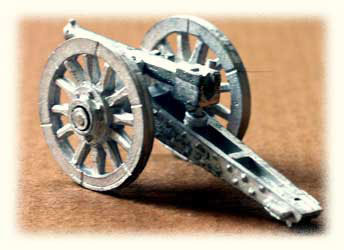
Can you identify this mysterious Italian Mountain Gun…? Askari Miniatures produce the illustrated Italian Mountain Gun – and while it is modelled on actual photographs of Italian guns it has not been positively identified exactly what model and calibre the weapon is.
Askari describe it thus: “Italian Mountain gun from the 1890s. Used by the Italian Askari camel and mule-mounted gun companies.“
I am attempting to identify exactly what weapon it is, when it entered service with the Italians (and for how long, i.e. was it still in use in WW1 or even WW2) and whether it may have been used by Nations other than the Italians (if it was for example an exported Krupp or DeBange gun or similar).
The Sword and the Flame [TSATF]
Larry Brom wrote TSATF in 1979, and 30 years later it’s still going strong with very little changes! Having played TTG’s Soldiers of the Queen* [SotQ] fairly extensively since it was published in 1987 (in my earlier wargaming years) until a long hiatus from all colonial gaming in the early 1990s, I was only introduced to TSATF in recent years for the first time…
* Not to be confused with the Victorian Military Society’s Journal “Soldiers of the Queen“!
Continue reading “The Sword and the Flame [TSATF]”Road Block on Highway 120 (sort of)
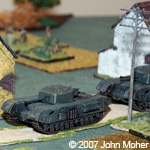 Kieran and I lined up yet another “Hit The Dirt” scenario, Highway 120 looked interesting, but my US & Italian forces were either still waiting to be based up or only part painted. So to get round the issue we transplanted the scenario to a later period – Summer 1944 in Italy after the fall of Rome… The Americans would be replaced by British Infantry with Churchills from a supporting Tank Brigade, and the Italians replaced with Germans. Otherwise the OOB was pretty close to what was in Hit the Dirt. Kieran would command the German Defenders, and I the British Attackers.
Kieran and I lined up yet another “Hit The Dirt” scenario, Highway 120 looked interesting, but my US & Italian forces were either still waiting to be based up or only part painted. So to get round the issue we transplanted the scenario to a later period – Summer 1944 in Italy after the fall of Rome… The Americans would be replaced by British Infantry with Churchills from a supporting Tank Brigade, and the Italians replaced with Germans. Otherwise the OOB was pretty close to what was in Hit the Dirt. Kieran would command the German Defenders, and I the British Attackers.
The game started with a general advance on a broad front – the leading British Infantry Company advanced with a 2 up 1 back formation with the Churchills supporting the centre & left of the advance. Initially no enemy were encountered and the advance moved swiftly covering half the distance to the stream.
Reconnaissance before Pontecorvo
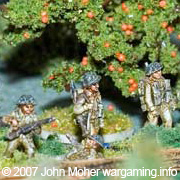 Kieran and I decided to play another “Hit The Dirt” scenario, and at the same time introduce another Auckland Wargaming Club member, Ben, to Crossfire. We selected ‘Reconnaissance Before Pontecorvo‘ (May 1944), as a suitable scenario that matched our available forces on the day and kept the size of the game to manageable with a new player.
Kieran and I decided to play another “Hit The Dirt” scenario, and at the same time introduce another Auckland Wargaming Club member, Ben, to Crossfire. We selected ‘Reconnaissance Before Pontecorvo‘ (May 1944), as a suitable scenario that matched our available forces on the day and kept the size of the game to manageable with a new player.
In the scenario a Canadian Company is attacking, or rather doing a reconnaissance in force, and a German Infantry Company is defending.
The scenario called for a single MMG Section for the British, but as we again had none available for the game, they would instead receive a single M4A1 Sherman to provide direct fire support to the Rifle Platoons.
Sahariana: “The Desert Jeep”
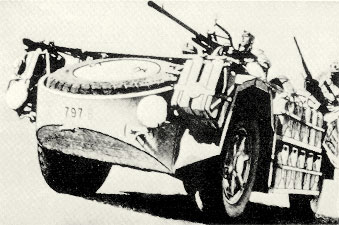
As used by Italian Reconnaissance Groups
Designation
Officially the Camionetta 42 ‘Sahariana’ – however, they are also referred to as – Camionetta ‘Sahariana’ AS 42 – or – Camionetta SPA 43 ‘Sahariana’ – (and incidentally the word Sahariana is singular, so if you are talking about more that 1 vehicle it is ‘Sahariane’).
The letters AS are the Italian code for North Africa, “Africa Settentrionale“, which pretty literally translates as “North African” but is often translated as “African Service” in English texts. Any equipment, unit organization, or formation that was designed or organized specially for North Africa was given this designation. In this case, it refers to the mechanical specifications of the vehicle being able to handle the harsh environment.
Giovani Fascisti: The “Young Fascists” (GGFF)
Gruppo di battaglioni GGFF – Giovani Fascisti
(at Bir el Gubi, November 1941)
GRUPPO GGFF HEADQUARTERS COMPANY
GRUPPO GGFF MG COMPANY
COY HQ
3 MG PLATOONS (each 3 x MMGs)
Continue reading “Giovani Fascisti: The “Young Fascists” (GGFF)”
Camicie Nere: The Blackshirts (MVSN & CCNN Combat Units)
M.V.S.N – The Milizia Voluntaria per la Sicurezza Nazionale
The MVSN started out as an organization not unlike the German S.A. (Brown Shirts), i.e. a Fascist Militia. They were purely a “Party” orientated organization, and like their German Counterparts wore a distinctive uniform – a Black Shirt and a Fez. This led to their popular nickname of Black Shirts (Camicie Nere – Camicie = Shirt & Nere = Black). Later the term CCNN was adopted for Black Shirt military units, and is taken directly from the initials of Camicie Nere. MVSN and CCNN are generally interchangeable, however the former primarily refers to political orientated parts of the Black Shirts, while the latter is generally used in reference to combat units.
Continue reading “Camicie Nere: The Blackshirts (MVSN & CCNN Combat Units)”

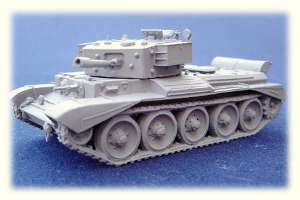
![The Sword and the Flame [TSATF]](https://wargaming.info/wp-content/uploads/The-Sword-And-The-Flame-Revision-1-1986-front-cover-1.jpg)